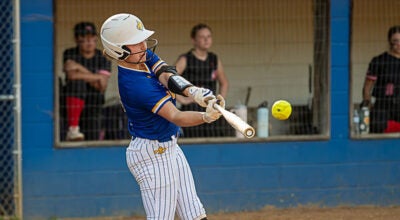A long journey
Published 3:35 pm Friday, January 8, 2010
Rhett Kolipano and his karate master, Jeff Bateman, journeyed to Japan 10 years ago and Kolipano bought a custom-made black belt.
Kolipano wasn’t a black belt yet, even though he started training in karate 15 years before then.
On the first day Bateman opened his karate school in August 1984, Kolipano was there, literally as Bateman’s first student.
For a decade after buying the black belt in Japan, Kolipano still wasn’t able to wear it and, as is custom, Bateman kept the belt in safe keeping. Bateman brought Kolipano with him on two trips to Okinawa as well. Bateman is a master in Okinawan Karate, the oldest, original form of karate.
Through moves, getting married, having children and other big changes in life, Kolipano stopped taking lessons, restarted and would stop again numerous times over the next 25 years.
“He got up to blue (belt), then he moved and stopped coming. Then suddenly, a couple years later, he came back again,” said Bateman.
About a year ago, Kolipano came back again, now to Bateman’s school in Hampton. Each time he came back, Kolipano started from scratch to regain the belts he had previously passed.
“I’d come and go, but I never wanted to give up. You find that (karate) becomes a part of you,” said Kolipano, who is a Chuckatuck resident. Kolipano is also known as “Rabbit” at Bateman’s school.
While Kolipano was a brown belt, one color away from a black belt, he was an assistant instructor for Bateman. One day a few months ago, while Bateman’s master instructor, ninth-degree black belt Sensei Tadashi Yamashita, was visiting the school in Hampton, Yamashita asked Bateman, who is a seventh-degree black belt, why Kolipano was still a brown belt.
“(Yamashita) felt the time, dedication and loyalty was there. He said, ‘No. Today, you promote him.’” Bateman said.
Yamashita and Bateman called Kolipano into an office and told him of the decision.
“It was a total surprise. I couldn’t have been anymore shocked,” said Kolipano.
There was still the matter of the physical test to become a black belt. Officially, once Yamashita and Bateman had made Kolipano a black belt, he was a black belt. Every other student under Bateman had passed a physical test however, so Kolipano wouldn’t want to take a shortcut.
The test, all in one span, which usually adds up to three to four hours, is made up of a five-mile run, 500 repetitions of four different types of kicks, 500 push-ups and 500 sit-ups.
Over the decades, Kolipano had competed and won medals many years at the Commonwealth Games in Roanoke. This past summer though, Rabbit won two gold medals and a bronze medal only six months after restarting in the sport.
Making the Games even more memorable was that it was the first time his daughter Dorhett competed. Dorhett won two gold medals in her belt group.
“It was great. It was just a very cool family thing,” Kolipano said.
His son Shandon is also taking lessons at Bateman’s school. Dad is an instructor in a class including his two children. After leaving karate in the past because of his kids, it’s turned out getting his children interested in karate was a big reason why Rabbit came back into it.
Now he teaches his classes while proudly wearing his custom, Japanese-made black belt. The wait has made it even more meaningful.






